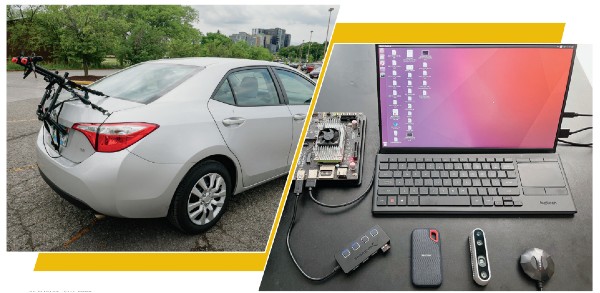An AI Algorithm for Better Roads
Sensor package would alert civic officials before potholes become a problem
Purdue researchers created a system that could dramatically improve how cities keep track of road conditions.
Lyles School of Civil Engineering Associate Professor Mohammad Jahanshahi and his research team have developed an inexpensive sensor package that can be attached to several vehicles, including volunteer vehicles, Uber/Lyft fleet, USPS and garbage trucks, etc.. These devices will scan the roads for damage as the vehicles drive over them and then can upload that information to a database for alerts and tracking.
“By and large, pothole detection and reporting comes entirely from people encountering the road hazards themselves and reporting them,” Jahanshahi said. “As a result, the potholes are almost always only reported on once they have already become a problem. With this device and reporting program, cities and counties will be able to respond to a developing pothole before it becomes an issue.”
Jahanshahi said that in addition to identifying and reporting on potholes, the device and the AI algorithm his team developed can also provide color-coded details such as size, depth, and growth of damaged areas.
Civil engineering PhD student Yu-Ting Huang developed the autonomous AI for the device.
“One of the biggest reasons why roads across the United States are damaged is due to lack of inspection,” Huang said. “If we can improve both the accuracy and frequency of inspection, we should see a dramatic increase in road quality throughout the country.”
The other bonus to this system, Huang said, is the opportunistic data collection and processing through crowdsourcing and internet-of-things that this system provides to improve road conditions in future smart cities.
“With manual inspections as they are now, it is both time-consuming and dangerous for people to keep track of road damage,” she said. “With this system, consistent, detailed reports can be made while ensuring a greater degree of safety for everyone who uses and inspects these roads.”
Jahanshahi said his team is currently working with the city of West Lafayette to test out implementation. From there, he said, they aim to gather more data and further improve their hardware and software.
“This is a pretty exciting point in our work,” Jahanshahi said. “We’re going from testing on a small scale to something much larger — which could potentially lead to seeing a dramatic improvement to this country’s infrastructure.” This work received the second place award in the best student paper competition by the ASCE Structural Health Monitoring and Control Committee at the ASCE Engineering Mechanics Institute (EMI) Conference 2022.

